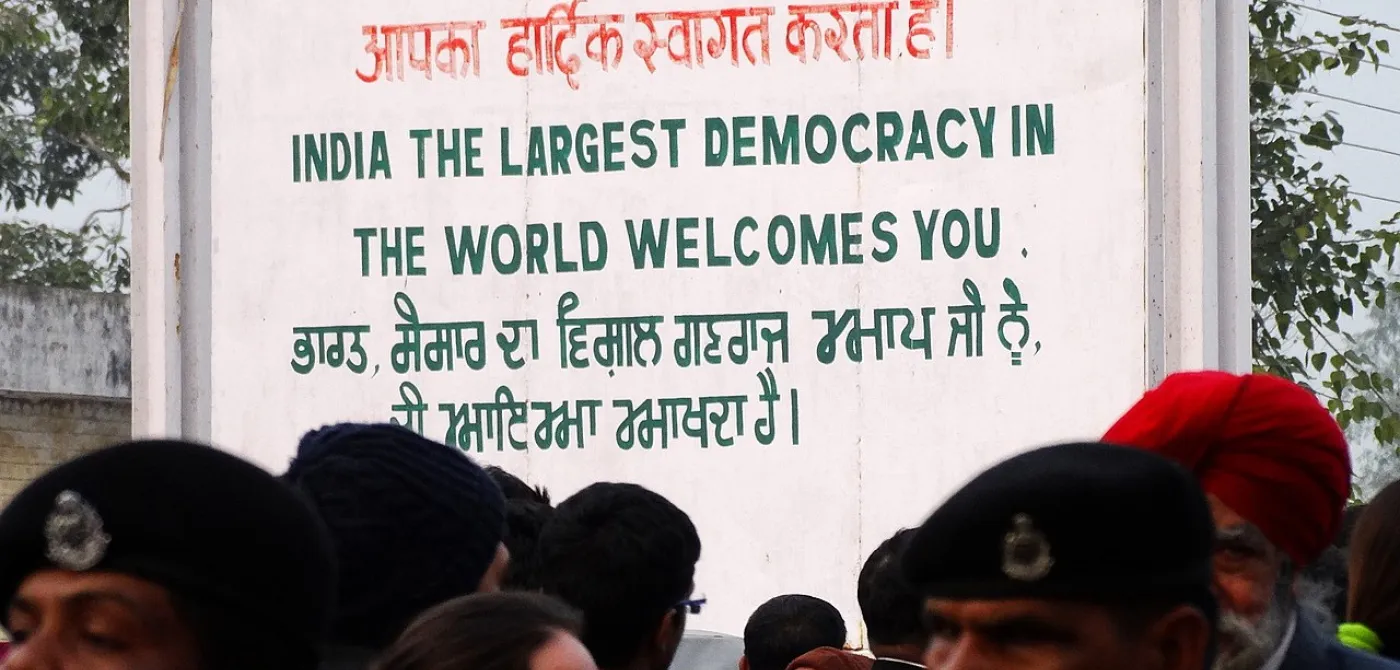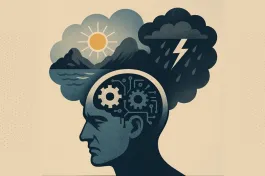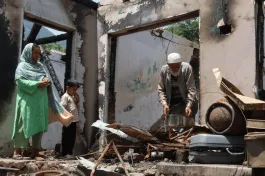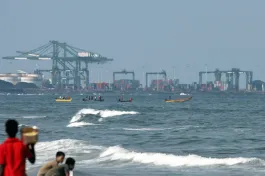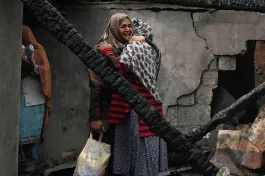On 30 August, Ramachandra Guha, whose works include a two-volume biography of Mahatma Gandhi; India After Gandhi: The History of the World’s Largest Democracy; and Environmentalism: A Global History, had a three-way online conversation with Ram Bhat, and university students from Chhattisgarh. The discussion was free flowing and covered a wide range of topics on contemporary issues in India, including the impact of majoritarian ideologies on the state and its institutions, on threats to the environment from current economic policies, and on Adivasi politics. Excerpts.
Majoritarianism, Institutions, and the State
Student: I want to ask a question with respect to the growing intolerance and majoritarian insecurities that I see right now around me. That is very visible through use of phrases like “Hindu khatre me hai” which I hear often. And this is something which is not particular to India. We have seen this in other countries as well. So, as a historian, why do you think the majority community happens to have such irrational insecurity?
Ramachandra Guha (RG): You are absolutely right. It is not peculiar to India and to understand it (not to excuse or apologize for it), take the example of Sri Lanka. Now in Sri Lanka, the Sinhalas were in a majority but yet they felt insecure about Tamils. The Tamils, who were a minority, took to English earlier than them, so they got jobs in colonial administration and in professions like the law earlier than them. So, when independence came, the more aggressive, chauvinist Sinhalas said: we must cut the Tamils down to size. They introduced a Sinhalese-only policy and it was followed by a civil war.
The great Sri Lankan anthropologist S. J. Tambaiah wrote a book on the civil war, in which he coined a new phrase about the Sinhalas. He said, “they are a majority with a minority complex.” It’s a very acute and perceptive phrase which applies to Hindus in India today. Although Sinhalas were 75% of the population, they still felt besieged and thought Tamils were taking away their jobs. Obviously the most awful, most extreme, and most striking example of this was probably Christian Germans, who felt that Jews were taking away everything away from them.
Hindus [...] dominate every sphere of Indian life — economic life, political life, cultural life, social life, intellectual life — and yet these Hindus still feel persecuted. This seems to be a really extreme example of a majority with a minority complex.
That phrase of Tambaiah is very important in understanding India today. When he used this phrase, I was starting my career. I was privileged to meet Tambaiah at a meeting and we chatted about his ideas, and it struck me that at the time — the early 1980s, before Operation Bluestar — his phrase applied to Sikhs. The Sikhs in Punjab were in a majority in their state but they were insecure about Hindus because often the Hindus were wealthier, they were traders, and so on.
Now in India today, the Hindus are being converted into a majority with a minority complex, with this significant difference compared to the situation that Tambaiah wrote about: in Sri Lanka, because the Tamils had taken early to English language education, they actually were disproportionately represented in the professional classes, the bureaucracy, university professorships; while Sinhalas were underrepresented. But in India that is not the case. The Muslims are economically, politically, socially, professionally underprivileged, as many studies and reports have shown.
Today you look at any profession, look at university professors, Muslims are underrepresented. Look at entrepreneurs, there is only one, Azim Premji, among the top bracket. There are some Muslims prominent in films, but not in the media. You will not find Muslim editors of major newspapers and TV channels. Hindus, and more precisely upper-caste Hindus, and still more precisely upper-caste Hindu males, dominate every sphere of Indian life — economic life, political life, cultural life, social life, intellectual life — and yet these Hindus still feel persecuted. This seems to be a really extreme example of a majority with a minority complex.
Hindutva radically departs from the legacy of great Hindus of the modern era like Vivekananda and Gandhi. Vivekananda and Gandhi did not think Hindus were perfect, they sought continually to make Hindus more caring, more just, more outward-looking.
The main target of the Hindu Right is Jawaharlal Nehru. But let’s leave Nehru aside for a moment because Nehru was a kind of non-religious person, though not an aggressive atheist. But I wish to say that Hindutva radically departs from the legacy of great Hindus of the modern era like Vivekananda and Gandhi. Vivekananda and Gandhi did not think Hindus were perfect, they sought continually to make Hindus more caring, more just, more outward-looking.
If you ask me what is the stupidest aspect of the Sangh Parivar’s worldview, it is their belief that India is destined to be the world’s teacher, the Vishwaguru. Have you seen our condition today? Do you think we can rule the world in any way? We can only teach the world if we improve ourselves. Vivekananda and Gandhi, if they were alive, would say: stop persecuting your women, stop oppressing Dalits, stop demonizing Muslims, embrace modern science, don’t glorify absurd theories like we invented plastic surgery, the aeroplane, etc. Cultural insecurity has morphed into a bizarre pride in our alleged achievements in the past. Hindus are going through a deep, collective, psychological crisis. But as a Hindu myself I want to say, we are not persecuted here in India, we are dominant in every way.
Ram Bhat (RB): This manufacturing of a majority with a minority complex. There seems to be an implicit debate or disagreement on the origin of this manufacturing. Some people will say 2014; some will say 1986, when Rajiv Gandhi interfered in Ayodhya and Shah Bano and a whole series of things that happened in the late 80s to early 90s. Other people would say the early years of the 20th century with the formation of the RSS [Rashtriya Swayamsevak Sangh] or some would say the 16th century. So, when and how do we actually locate the origins of this phenomenon?
RG: That’s a very good point there, because you know it is like Serbs in Yugoslavia who also went further and further back in history to examine the roots of their present predicament. But the more you stoke ancient memories whether real or mythical, the more problems you face in the present.
Even if something awful happened in the 16th century, it cannot be answered by something awful in the 21th century. With independence and a new Constitution, there should have been a freeze on such disputes.
If you look at the Babri Masjid question, I think the mistake that historians in places like JNU [Jawaharlal Nehru University] made was to go into the debate about whether there was a temple there. The response should have been: even if something awful happened in the 16th century, it cannot be answered by something awful in the 21th century. With independence and a new Constitution, there should have been a freeze on such disputes. To answer the Hindutva accusation that the Muslims were evil rulers with the counter that ‘no, no, some Mughals were very benign and generous rulers’ is a mistake. The argument should rather be: ‘the poor rickshaw-wallah, who is a Muslim in Delhi today has nothing to do with Babar or Aurangzeb. He/she must be treated as an equal citizen as the Constitution proclaims them to be.’
I don’t know how long this persecution complex will last. The minds and hearts of many Hindus will be prey to this sense of persecution because it is malevolently forced upon them. Go back to the example of Sri Lanka; to a limited extent the Sinhala chauvinists had a point that Tamils were better educated. But the Muslims in India are not better educated than Hindus, they don’t have better access to capital, they are underrepresented in professional classes, and so on forth. By any standard — objective or subjective — Muslims are almost at the level of Dalits and Adivasis in being disadvantaged in economic, social, and political terms.
Fundamentalists are rivals and competitive. They feed on each other and that is what is happening in South Asia today.
Student: If we are talking with respect to India, you mentioned that we do not know from where this complex is coming. But this is something which is happening in Myanmar, with Rohingyas, as well. Do you picture this as a larger phenomenon and why this complex happens?
RG: Your invocation of Myanmar is relevant here. Basically, one form of majoritarianism feeds upon another. So already we had Bangladesh and Pakistan, which are essentially Islamic majoritarian states. Now we have Myanmar and Sri Lanka which are Buddhist majoritarian states and India is joining the club of South Asian majoritarian states. When these countries became independent, even Pakistan was a homeland for Muslims but it was not an Islamic Republic. Bangladesh was constituted as a secular republic and Islam was added much later to its constitution. In Sri Lanka it is only in 1971, twenty-three years after independence, that Buddhism is made a kind of state religion.
What is really interesting is that in South Asia, there was only one large country in which the state identified with a religion, which was Nepal, where the king was regarded as the incarnation of Vishnu. Now Nepal is no longer a Hindu state but India has effectively become one, and the other countries in the region have also merged faith with state. So majoritarianism in South Asia is all pervasive. India had once proudly stood apart because of its democratic traditions, because of the traditions of its founders like Tagore, Gandhi, Nehru, and Ambedkar, who were opposed to majoritarianism, who were opposed to defining our political identity with a single religion. But now we have followed Pakistan, Bangladesh, Sri Lanka and Myanmar. Fundamentalists are rivals and competitive. They feed on each other and that is what is happening in South Asia today.
Patriotism is now being replaced by a narrow-minded, parochial, prejudiced form of nationalism which I call jingoism, whose slogan is ‘Hindi, Hindu, Hindustan’.
Student: The recent visit of the prime minister for the Bhumi Poojan ceremony of the Ram temple in Ayodhya prompted various important personalities to express their idea of Ram. Gandhi played an important role in evoking an image of Ram in the public mind. What was his idea of Ram and how is it different from present discourse on the Ram temple?
RG: The first thing about Gandhi’s Ram was that it was in his heart. He did not need a temple to show his devotion. In fact one of the remarkable aspects of Gandhi’s religious life was that he virtually never visited a temple. When he was growing up, as a little boy he went with his mother to the temple. In his adult life, he called himself a Hindu but rarely went to a temple. In the 1940s, when the famous Meenakshi temple in Madurai admitted Dalits for the first time, he went there. Gandhi did not need a grand temple to show his spirituality and devotion to Ram.
The second difference is that Gandhi’s Ram is also called Allah as in ‘Ishwar Allah tero naam’. In a recent column in the Times of India, Swaminathan Aiyar wrote that now Modi has gone to the temple in Ayodhya, he should go to the inauguration of the mosque in Ayodhya as well. There is a lesson from Gandhi here. The last religious shrine Gandhi visited was a tomb to a Sufi saint outside Mehrauli in Delhi, on 27th of January 1948, a few days before he was assassinated. There had been terrible Hindu-Muslim riots in Delhi in which Muslims had suffered disproporationately. There was an annual Urs festival of that Sufi saint and Gandhi went to the site. This was a remarkable gesture of reconciliation. If Modi attends the inauguration of the mosque in Ayodhya it would be a valuable symbolic gesture in the spirit of Gandhi. The question is, will Modi go?
Student: Do you think the nature of nationalism has changed over the years in India? If yes, how and what are the factors responsible for that?
RG: In short, yes it has changed. For a long answer, you can refer to an essay I wrote called ‘Patriotism versus Jingoism’, in Outlook magazine, which was based on a lecture in memory of Justice Sunanda Bhandare. Nationalism comes in many varieties. I distinguish two varieties in this lecture. The first is patriotism which I associate with people like Gandhi, Tagore, Nehru, and Ambedkar and which involved looking critically within, emancipating women and Dalits, learning from the best of the rest of the world, not allowing any particular religion or a particular language to dominate over others; a sort of compassionate and broad-minded understanding of India. This patriotism is now being replaced by a narrow-minded, parochial, prejudiced form of nationalism which I call jingoism, whose slogan is ‘Hindi, Hindu, Hindustan’, and which gives Hindus primacy over non-Hindus, gives Hindi-speakers primacy over non-Hindi speakers, and gives primacy to hatred to Pakistan over love and understanding of India itself.
Student: How much can you rely on the Supreme Court in the current scenario? To what extent is the judiciary reliable? Are laws like contempt of court valid in the present?
RG: Sadly, we cannot rely on the judiciary very much. It has largely capitulated, it has become weak and timid. Some high courts and judges are independent minded — in Karnataka, Mumbai, Allahabad, to some extent. I wrote a piece recently where I said the Supreme Court was becoming a collaborationist court. It is collaborating in the creation of authoritarianism. Now if you want a restoration of democracy you need political pluralism. The opposition has to get its act together and pose a vigorous electoral challenge in different states and in the next general election. That could be a more practical route to restoring democracy than to put your faith in the Supreme Court.
One does not approach the court as a temple. It is a living institution subject to popular pressures in democracy like any other democratic institution.
As long as there is competitive politics, institutions tend to be more autonomous. In the 1980s and 1990s, when the hegemony of the Congress declined, the bureaucracy, the Supreme Court, the Election Commission, all recovered their autonomy to a large extent. The concept of ‘contempt of court’ is totally outmoded. The Supreme Court has diminished itself and came out of the Prashant Bhushan episode very badly. Criticism of all institutions must be allowed so long that it does not promote violence. The Supreme Court of the last few years will be judged very harshly by history. But as long as we have competitive politics, do not despair.
RB: Just want to add that it is very important one does not approach the court as a temple. It is a living institution subject to popular pressures in democracy like any other democratic institution. So this whole matrix of expectations that one has with the court as a holy institution should be replaced with a more active engagement, making it known that the public is not happy with the judiciary.
Student: In any democracy, if one branch acts arbitrarily the other two act to check it continuing the system of checks and balances. But the current system seems that it has subverted power for its own benefit. How do you see the future of the country?
RG: I was a college student during the Emergency and then I have studied it as a historian. What are the parallels and departures between the 1970s and today? The parallels are obvious. The first is the presence of an authoritarian leader. Indira Gandhi said: I am the party, I am the government, I am the nation. Narendra Modi is saying the same thing.
The second is the cult of personality. We have a ruling party whose members show absolute sycophancy and chamchagiri towards the prime minister. The third is the subversion of institutions. Mrs Gandhi also tamed the press, made the judiciary subservient, and used the bureaucracy to hound political opponents. During the present regime however, the autonomy of institutions has eroded even further. As I have said elsewhere, Narendra Modi is Indira Gandhi on steroids.
However there are differences as well. Some give hope, others make you despair even more. Unlike during the Emergency, today many major states are outside the purview of the ruling party. In June 1975, of all the major states of India, only Tamil Nadu was ruled by an opposition party, DMK [Dravida Munnetra Kazhagam], which was soon dismissed. Thus, there was no viable opposition in place. Today you have Kerala, Tamil Nadu, Andhra, Telangana, West Bengal, Odisha, Maharashtra, Chhattisgarh, and Jharkhand — at least nine major states not ruled by the BJP. The anti-CAA [Citizenship Amendment Act] protests happened mostly in these states. Unfortunately, the pandemic has put an end to that. Take the national Disaster Management Act [DMA] for instance, the central government is controlling everything through the DMA.
Another difference is that even if the mainstream media has been largely crushed, you have open spaces of social media. Earlier, a scholar in Tamil Nadu could never have had a conversation with someone living in the northern parts of the country. The media is partisan and sycophantic, but not as suppressed as it was during the Emergency.
The most dangerous departure, however, lies in the majoritarian politics of the ruling party. The poison that Hindutva is spreading in the minds and hearts of ordinary Indians was not present in the 1970s. Indira Gandhi had many faults but she was not a majoritarian. She was not a religious chauvinist. She believed in the cosmopolitan, pluralist idea of India. She had been trained by Tagore, Nehru, and Mahatma Gandhi. So there are many striking similarities but there are important differences as well.
Environmental protection
Student: In the 21st century we can clearly comprehend the dangers of a capitalistic economy and neoliberal democracy since we can see the ecological degradation and the kind of disparities it creates. Do you think that we need to move out of these old economic and political systems and find new alternatives or do you think these systems give feasible space to make changes?
If every panchayat has a right to its own mineral resources [...] it’ll lead to a much more organic, balanced, and sustainable development.
RG: Clearly not. Mahatma Gandhi had warned about this 90 years ago when he said (I am quoting from memory): “God forbid that India industrialize after the manner of the west. If it follows the European models of industrialization, it would strip the world bare like locusts.”
I think political decentralization is a very important way in which you can have more responsible use of natural resources. If every panchayat has a right to its own mineral resources and every panchayat can independently negotiate with the mine-owners, and tell them that you can take so much ore provided you put so much money back into our schools, our hospitals, and our roads; it’ll lead to a much more organic, balanced, and sustainable development. So, there are different models.
This does not mean abolishing capitalism because you need innovators and entrepreneurs and risk-takers. Socialist economics doesn’t work. In fact, Eastern Europe under communism was as environmentally destructive as any capitalist country had been. By using new technologies; energy-saving technologies, material-saving technologies I think new paths are possible, but political decentralization and an independent media to report on this are both imperative.
One of the problems about the Indian media today is that because it’s captive to corporate interests, it will never write about environmental degradation caused by the corporations. I think an independent media, political decentralization, and smart use of the latest ecological scientific knowledge — these three things together can put us on a path to sustainable development. And we have the expertise here. Jairam Ramesh [... who] was probably our only sensible environment minister and one of the things he did in his tenure was to appoint a committee headed by our greatest ecologist, Madhav Gadgil, recommending ways in which the Western Ghats could be managed more sustainably. That committee’s report was rejected, Jairam Ramesh was transferred to another ministry and all the safeguards that the Gadgil committee had put in place were not heeded and that’s why you had the floods in Kerala that took place several years ago. So, I think scientific expertise is something which our governments must not neglect. The Congress neglected it a little bit, this government neglects it totally; I mean, this government has contempt for experts because Narendra Modi thinks he knows everything.
Student: The draft EIA [Environment Impact Assessment] notification that had come up recently is said to have weakened the Forests Rights Act [FRA] and the rights of Adivasis in general, what do you have to say about this?
In Gadchiroli [district of Maharashtra], community forest management has helped in increasing employment and tribals are harvesting bamboos sustainably. Wherever FRA and panchayati raj are strong there would be wiser use of resources.
RG: It is hugely problematic. I recently wrote a piece for NDTV on the Char Dhaam Pariyojana which has the potential of destroying the Himalaya. The government is trying to build a massive highway in the most fragile regions. This government is reckless in its abuse of the environment. In the case of EIA this government is captive to mining interests, this is no secret that firms like the Adanis are close to them and under cover of the pandemic many things are done to help these companies. To be fair, the Congress had also done much the same thing, except in the short period when Jairam Ramesh was the environment minister.
If the FRA is implemented properly then we can have great results. For example, in Gadchiroli [district of Maharashtra], community forest management has helped in increasing employment and tribals are harvesting bamboos sustainably. Wherever FRA and panchayati raj are strong there would be wiser use of resources. The EIA draft is a short-sighted route being adopted mostly to facilitate highway construction and mining activities.
Adivasi movements
Student: There is a movement in Jharkhand, the Pathalgadi movement. In this movement, Adivasis are writing articles from the Constitution on stones and they are showing the educated class what the Constitution really is. So how do you see this method taken up by the Adivasis to fight for their rights?
RG: I agree with you. It seems to be a very vibrant and creative movement. Nandini Sundar had a good article on it in The Wire.
I think the provisions in the Constitution, applying to the Fifth Schedule and the Sixth Schedule granting access to natural resources to the adivasis, must be enabled and made active. In 2006, I was in Chhattisgarh when the civil war was at its most intense and we met the notorious founder of Salwa Judum, Mahendra Karma, and we told him this. We said, the Fifth and Sixth Schedules allow you to give mining rights to the adivasis, you don’t have to call in Tatas and Adanis. So, I think the Constitution itself has some very flexible creative procedures which can be used to mitigate Adivasi suffering and to enhance their rights. It’s very good that the new government in Jharkhand has removed the cases that the old government had filed against the Pathalgadi activists.
Unlike Dalits, Adivasis don't have a coordinated political voice [...] This voicelessness combined with economic deprivation had led the Naxalites to move into Adivasi areas; but I have no sympathy with the Naxalites.
Student: What future do you see of the Adivasi movement and do you find any possibility of success of Adivasi movements for autonomy and their rights over natural resources in the present system of government-corporate nexus?
RG: I have written about this in detail in an essay in my book Democrats and Dissenters. There I argued that Adivasis are even more oppressed than Dalits along many dimensions like education, health, sanitation and deprivation of natural resources. Commercial forestry and large-scale mining have dispossessed them. There is a study by Dr Walter Fernandes pointing out that between 1950 to 1980, at the height of planned development, 40% of those displaced were Adivasis.
After economic liberalization they have suffered equally or even more. Under the cover of a pandemic, many coal mining licenses have been given to corporates. The journalist Chitrangada Choudhury and the anthropologist Nandini Sundar have documented in detail the condition of Adivasis today. Unlike Dalits, Adivasis don't have a coordinated political voice. Dalits have had a mobilizing figure like Ambedkar to assert their constitutional rights. Further, the reservation system has benefited the Adivasis from the North East and from Rajasthan like the Meenas; but not the bulk of them living in Chhattisgarh, Madhya Pradesh, Odisha, and Jharkhand. This voicelessness combined with economic deprivation had led the Naxalites to move into Adivasi areas; but I have no sympathy with the Naxalites, since I totally abhor violence as a political strategy and political violence has only intensified the suffering of the Adivasis.
[The] original idea of Jharkhand [was] as a state to be formed by joining all the contiguous tribal areas of [eastern and central India]. If Jharkhand would have been formed according to the original idea then perhaps tribals would have better represented.
Jaipal Singh started the Jharkhand movement in the 1930s. In the 1950s, when the States Reorganization Commission was formed, Jaipal Singh made a representation and presented his original idea of Jharkhand as a state to be formed by joining all the contiguous tribal areas of Bihar, Madhya Pradesh, Andhra Pradesh, Odisha, and Maharashtra. But later Jharkhand was carved out from the tribal districts of Bihar alone and today when there is so much immigration to cities like Dhanbad, Ranchi, and Jamshedpur; Adivasis have become a minority with less than 30% of the population. If Jharkhand would have been formed according to the original idea then perhaps tribals would have better represented. The route to Adivasi emancipation now seems to be even harder than for Dalit emancipation. It's a bleak situation and a big concern for our country.
RB: Just to add to that, now there is some partial mobilization among Adivasis, like the Bharatiya Tribal Party in Rajasthan [which] is doing a good job in mobilizing but they face opposition through the rhetoric of Adivasi vs Vanvasi by RSS. Social media has a huge role to play in terms of possibilities for greater mobilisation.
RG: We have seen parties like Jharkhand Mukti Morcha and Gondwana Gantantra Party, but a pan-Adivasi party might be a way for them to have better representation.
Student: The adivasis of Chhattisgarh have been fighting a long battle for the Hasdeo Arand region, containing 160,000 hectares of forest area, against the Parsa coal project, but the government is providing the forest region to the Adanis. So, assuming that the current course of action fails to sensitize the government, what are your views about the possible alternative course of action that can be taken?
Coal is not the future, not for the climate nor the country, and it is not the future for Chhattisgarh.
RG: I hesitate to recommend a course of action. I’m not an activist, I don’t live in Chhattisgarh, it’s not fair of me to tell you what to do. But it’s clearly an awful move by the government. I mentioned Chitrangada Choudhury, she wrote some excellent articles on the project, please read them, circulate them, get them translated into Hindi, into Gondi, whatever languages, so people know how destructive this is. It’s a tragic misallocation of government power. It’s a misallocation that will have immediate harmful consequences for the adivasis but long-term consequences for India itself. You can’t afford to let so much natural forest that takes millennia to grow and to mature to be brutally treated like this. Coal is not the future, not for the climate nor the country, and it is not the future for Chhattisgarh. But it is not fair of me, who doesn’t live in Chhattisgarh to give political advice on it, except to endorse what you said that it’s a totally unnecessary and destructive step.
RB: Could I just add my two pence on that? Some of the gram panchayats in the Parsa East Kenta Basan region have been on dharna for many days. Chitrangada’s reports have mentions of that, and some of the stringers in that area have been trying to cover what those panchayat leaders are saying. If you students who are from Chhattisgarh can amplify some of those voices then suddenly from a subterranean discourse it becomes more mainstream; all of you are on social media and are connected to wider networks. You could actually play a big role in amplifying some of those voices.



